Poll
 | 25 votes (49.01%) | ||
 | 16 votes (31.37%) | ||
 | 7 votes (13.72%) | ||
 | 4 votes (7.84%) | ||
 | 12 votes (23.52%) | ||
 | 3 votes (5.88%) | ||
 | 6 votes (11.76%) | ||
 | 5 votes (9.8%) | ||
 | 12 votes (23.52%) | ||
 | 10 votes (19.6%) |
51 members have voted
You are correct that in the real world some people will take/go for smaller prizes, while others, similar to lottery players, go for the high risk ones. So some players will lose EV - it's the same concept as people taking even money on Blackjack.
How many times have you seen on a quiz show a losing contestant who risked all in the final round, saying I came with nothing and am happy to leave with nothing; while a student usually bails out saying the money will help to get a car/holiday/deposit on a house etc.
PS Here's a easy puzzle for us, but feel free to try it on a friend.
Which one of these words is the odd one out.
SIN TAN FUN COS
Quote: charliepatrickWhich one of these words is the odd one out.
SIN TAN FUN COS
link to original post
:strip_icc()/pic7587520.png)
Bob is a banana farmer who lives in a banana republic. He sells his bananas at his stall in the town market. Everyday he travels from his farm to the market with three sacks which can hold 30 bananas each. None of the sacks can hold more than 30 bananas.
He starts with 30 bananas in each sack. On his way to the market, he must pass through 30 checkpoints, and at each checkpoint he has to give one banana for each sack to the authorities.
How many bananas remain after he goes through all the 30 checkpoints?
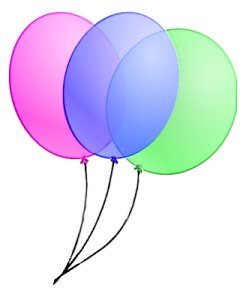
Youíre driving a car. The windows are closed. In the back seat is a kid holding some helium balloons.
You turn right. You and the kid sway to the left.
What do the balloons do?
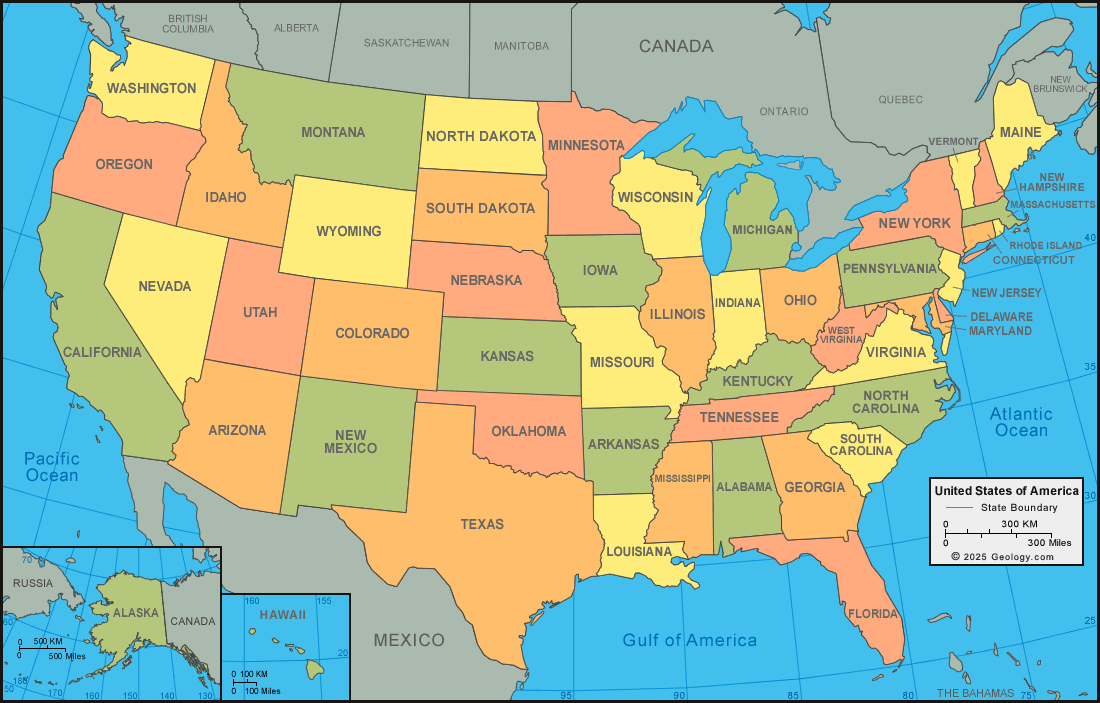
Montana, Wyoming, and South Dakota meet at one point. Maryland, Virginia, and the District of Columbia meet at two ó at Washingtonís westernmost and southermost points along the Potomac River.
Name three U.S. states all three of which meet at three different points.
Bananas: 25
Balloons: The helium balloons move with the car through its right hand turn.
Geography: Washington, Montana and Indiana
At checkpoints 11-25 he pays 2 bananas each. 2x15=30; so after that he only has 30 bananas left.
At checkpoints 26-30 he pays 1 banana each. 1x5=5, so after that he is left with 25 bananas, that over 72% tax!
btw there are some interesting bits and bobs about other states and places and some interesting quirks when looking at the US/Canada border.
Hyder, Alasks - only accessible via Canada (a biking convention meets there as it's the easiest way to knock off Alaska)
Port Roberts - this area got cut off from Canada due to being south of the 49th parallel, this was a real problem during Covid as they couldn't get to many shops.
North West Angle - a quirk this includes the most northerly point of contiguous US (and apart from line errors, the only area north of 49th).
Akwesasne - while the casino is in the US, there is no border crossing if you go into the town in Canada.
Aroostook Golf Course - on the US-Canada border, so you can tee off in one country and the green is in the other.
There are several places where you legally have free access across the border, e.g.Peace Park, International Peace Garden.
Quote: acesideIíve been thinking about this too. There is also a difference in variance for the player to pick the car or the jewelry. I guess for a less amount of playerís variance, the strategy should be to pick the jewelry, rather than the car. Is this right?
link to original post
The way I meant the problem, the player is trying to maximize expected value, not expected additional utility.
Kentucky, Tennessee and Missouri. There is a enclave (is that the right term?) of Kentucky surrounded by Missouri on all sides except Tennessee to the south.
It's easier to explain with a map.
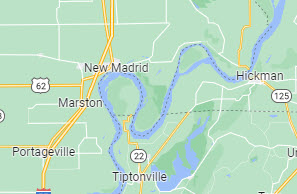
Quote: gordonm888
Bananas: 25
Balloons: The helium balloons move with the car through its right hand turn.
Geography: Washington, Montana and Indiana
link to original post
Quote: charliepatrickAt checkpoint 1-10 he pays 3 bananas each. 3x10=30; so after that he only has 60 bananas left.
At checkpoints 11-25 he pays 2 bananas each. 2x15=30; so after that he only has 30 bananas left.
At checkpoints 26-30 he pays 1 banana each. 1x5=5, so after that he is left with 25 bananas, that over 72% tax!As the air is heavier, the air will go to the left and the balloons to the right.The name is xxxxxxxx Bend.
Quote: Wizard
Kentucky, Tennessee and Missouri. There is a enclave (is that the right term?) of Kentucky surrounded by Missouri on all sides except Tennessee to the south.
It's easier to explain with a map.
link to original post
Correct!!
Very good.
If the windows were open, the wind would blow the balloons into your face causing you to drive into oncoming traffic. Good fun.
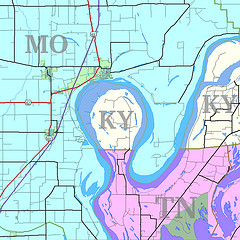
As the Wizard mentions, Missouri, Kentucky, and Tennessee meet at three points around the Kentucky Bend, a 17-square-mile bit of southwestern Kentucky orphaned by an oxbow in the Mississippi River. Admittedly this one is only "easy" if you're familiar with the area (in which case it's really easy) or, (like CP) are a geography buff.
Politically, this isolated Kentucky quirk is no different than a populated offshore island for any coastal state.
..........................................
"Of course not, dear - I love you much more."
"Then prove it!"
"OK... Let R be the set of all lovable objects..."

A robot performs coin tossing. It is poorly designed, it produces a lot of sounds, lights, and vapors, and it takes one hour to toss a coin. Yet in the end, when the coin finally lands, it somehow has equal probability of showing heads and tails.
Two scientists, A and B, enjoy observing this robot and, by analyzing its unusual and faulty behavior, they became fairly decent at guessing whether the coin will land heads or tails half an hour before the coin is released from the robot's hand. The scientist A has an 80% chance of successfully predicting the outcome, while the scientist B is successful 60% of the time.
The robot started its routine, and the scientist A predicts the coin will land tails. The scientist B predicts the coin will land heads.
Can you calculate the probability that the coin will land heads?
Heads
A is wrong and B is correct so relative Prob =0.2*0.6 = 0.12
Tails
A is correct and B is wrong so relative probability P = 0.8 * 0.4 = 0.32
Absolute probability that the coin will land heads = 0.12 / (0.12+0.32) = 3/11
Quote: gordonm888
Heads
A is wrong and B is correct so relative Prob =0.2*0.6 = 0.12
Tails
A is correct and B is wrong so relative probability P = 0.8 * 0.4 = 0.32
Absolute probability that the coin will land heads = 0.12 / (0.12+0.32) = 3/11
link to original post
A nice shot but no.
It's a tricky one.
I'll buzz it out later tonight.
Quote: GialmereCan you calculate the probability that the coin will land heads?
link to original post
Quote: GialmereIt's Toughie Tuesday. Let's flip a coin...
A robot performs coin tossing. It is poorly designed, it produces a lot of sounds, lights, and vapors, and it takes one hour to toss a coin. Yet in the end, when the coin finally lands, it somehow has equal probability of showing heads and tails.
Two scientists, A and B, enjoy observing this robot and, by analyzing its unusual and faulty behavior, they became fairly decent at guessing whether the coin will land heads or tails half an hour before the coin is released from the robot's hand. The scientist A has an 80% chance of successfully predicting the outcome, while the scientist B is successful 60% of the time.
The robot started its routine, and the scientist A predicts the coin will land tails. The scientist B predicts the coin will land heads.
Can you calculate the probability that the coin will land heads?
link to original post
Iím probably missing something but:
Quote: unJonIím probably missing something but:
I donít see how you know without knowing whether the error terms of scientist A and B are correlated or not.
link to original post
I assumed there was no correlation.
I have a prediction there will be some argument about the wording of the question once it's revealed why 3/11 is not correct.
Quote: unJonIím probably missing something but:
I donít see how you know without knowing whether the error terms of scientist A and B are correlated or not.
link to original post
Correct!
Or at least this is the best response.
:strip_icc()/pic7591636.png)
-------------------------------------------------
The best joke on mankind is that computers ask humans to prove they are not robots.
Quote: GialmereOr at least this is the best response.
link to original post
*groan*
This was like reading a murder mystery, in which you consider all the clues and the suspects -and then learning that the murderer is the person editing the author's book, and that the murderer has corrupted the information in the text of the book in order to deceive you. Which would be clever on a meta level but extremely unfulfilling to its intended audience.
A pox on this puzzle!
Heh. Let's see if this one sparks controversy...
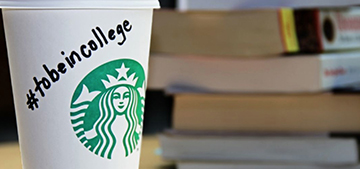
The new campus of University College is a perfect circle of radius 1km. Starbucks plans to open 7 coffee shops on campus.
Where do the coffee shops have to be placed in order to minimize the maximum (straight-line) distance that a person anywhere on the campus has to walk to find an overpriced cup of jo?
Quote: ChesterDogIf 6 coffee shops are on the circle at the vertices of an inscribed regular hexagon and 1 coffee shop is at the center of the circle, the maximum straight-line distance anyone would have to walk for coffee would be (one-third of the square root of 3) km.
link to original post
A good guess, but no.
You will notice that the furthest distance to a coffee shop is 1/2, and the Y-coordinates are +/- 3/4, and the X-coordinates are +/- 3/8 or +/-3/4.
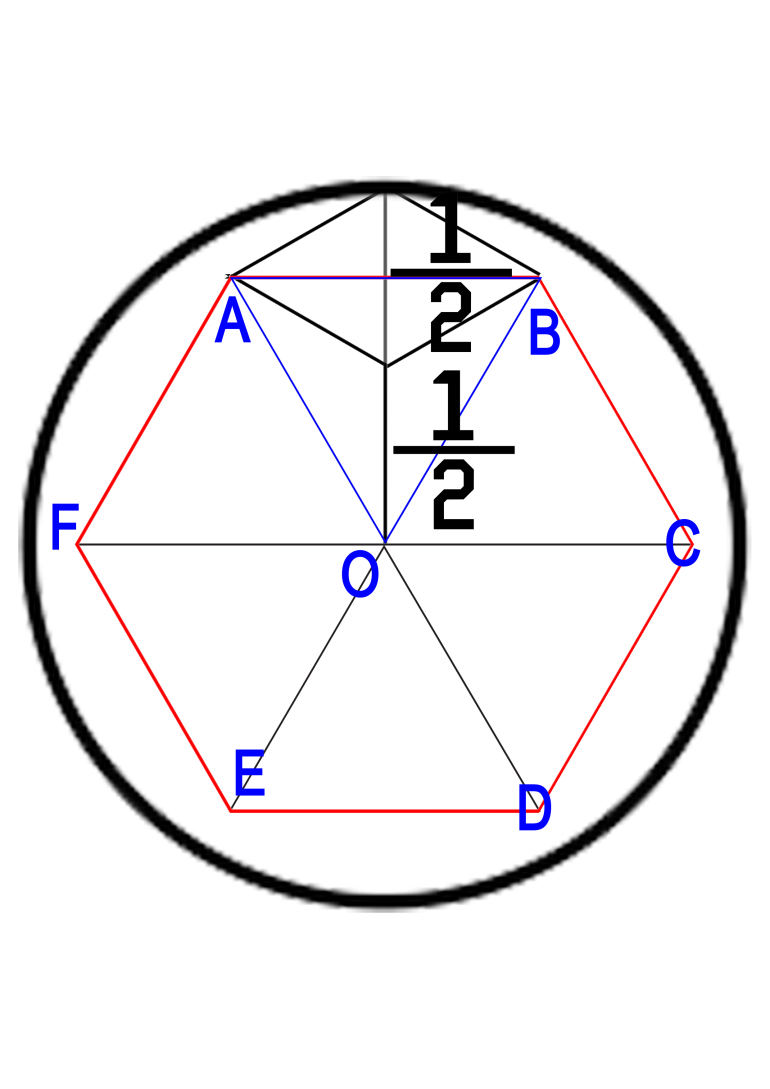
Quote: gordonm888A pox on this puzzle!
link to original post
Amen. Here is one G might like, which I hate.
Put one in the middle.
Then, think of the campus like a clock. Put one 1/2 km from the circumference at the 12, 2, 4, 6, 8, and 10:00 spokes.
The furthest one can be from the nearest Starbucks is 1/2 km. These locations will be on the 1, 3, 5, 7, 9, and 11:00 spokes, in the middle of the nearest three Starbucks and on the circumference.
Quote: charliepatrickThey do have to be at points on a hexagon but the hexagon can be inside the circle. For the inner equilateral triangles the furthest away a place can be, is in the middle of the triangle. A point on the outside of the hexagon will have similar logic, so one can construct a similar triangle - see diagram - whereby the point, in this case North Pole, is the same "furthest" distance away.
You will notice that the furthest distance to a coffee shop is 1/2, and the Y-coordinates are +/- 3/4, and the X-coordinates are +/- 3/8 or +/-3/4.
link to original post
Correct!
Very good.
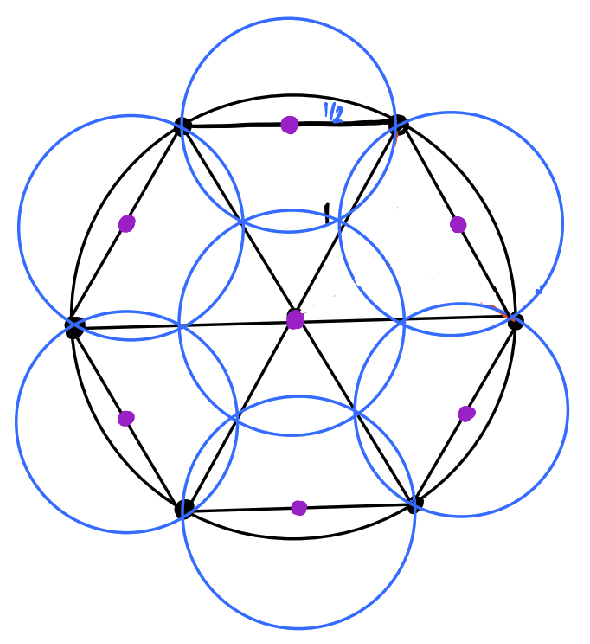
--------------------------------------------
2) Isaac Newton's birthday!
3) I could only get arbitrarily close to my textbook. I couldn't actually reach it.
4) I have the proof, but there isn't room to write it in this margin.
5) I was watching the World Series and got tied up trying to prove that it converged.
6) I have a solar powered calculator and it was cloudy.
7) I locked the paper in my trunk but a four-dimensional dog got in and ate it.
8) I couldn't figure out whether i am the square of negative one or i is the square root of negative one.
9) I took time out to snack on a doughnut and a cup of coffee and spent the rest of the night trying to figure which one to dunk.
10) I could have sworn I put the homework inside a Klein bottle, but this morning I couldn't find it.
There is a circular grass field of diameter 6. A goat is chained with a chain of length 2 to an arbitrary point on the circumference. What is the area of the field the goat can graze?
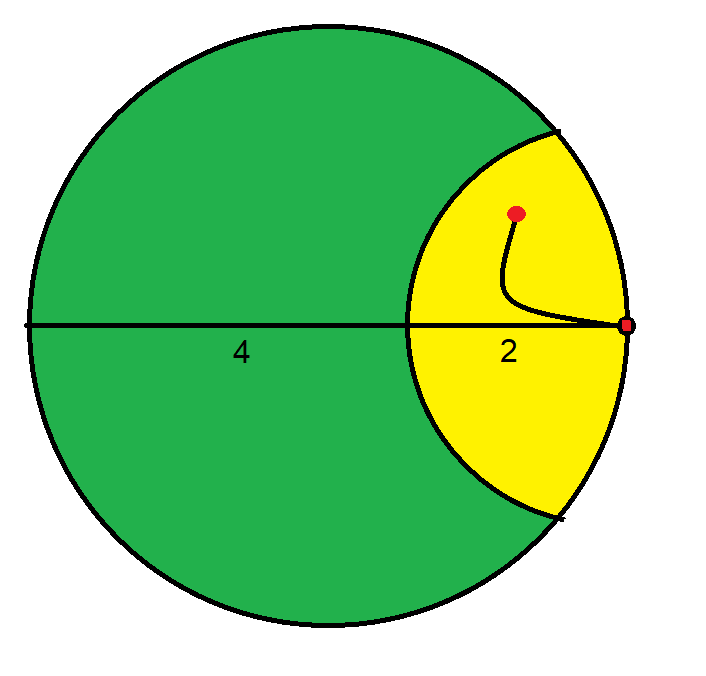
I get that the goat can graze this area:
9 arctan[ 4sqrt(2) / 7 ] + 4 arctan[ 2sqrt(2) ] - 4 sqrt(2), which is approximately 5.384.
Gialmere asked a related goat-in-a-field question: https://wizardofvegas.com/forum/questions-and-answers/math/34502-easy-math-puzzles/54/#post845141
I got a futures sheet from William Hill offering the following bets:
-290 (i.e. you bet 290 to win 100) that Georgia does not win this season's CFP championship game.
-900 (i.e. you bet 900 to win 100) that Alabama does not win this season's CFP championship game.
Using these two bets, construct a bet where you lose a particular amount if either Georgia or Alabama wins, and you win a particular amount if neither of them does.
In other words, you bet some amount A on Alabama not to win, and some amount G on Georgia not to win, such that the amount you win or lose in the two bets combined is the same if Alabama does win as it is if Georgia does win.
What are the odds on winning that bet, in terms of the amount that you would lose if you lost the bet?
Sticking with the £390 book - in your case you're taking the bets; so you bet $351 to win $39 and $290 to win $100. The total outlay is $641. If either teams wins you get back one of the bets which is $390, i.e. a loss of $251. If neither team wins you get $780, i.e. a profit of $139.
Thus you are essentially betting $251 to win $139: odds of 139/251 or -180.576 in US odds.
Quote: ChesterDog
I get that the goat can graze this area:
9 arctan[ 4sqrt(2) / 7 ] + 4 arctan[ 2sqrt(2) ] - 4 sqrt(2), which is approximately 5.384.
Gialmere asked a related goat-in-a-field question: https://wizardofvegas.com/forum/questions-and-answers/math/34502-easy-math-puzzles/54/#post845141
link to original post
Hmmm. I'm not saying you're wrong, but that's not what I get. My answer is a bit less:
9arcsin(1/3) - 2*sqrt(2) + 4arcos(1/3) =~ 5.153943.
We could use a third opinion on this one.
I show if you bet $351 on Alabama and $290 on Georgia, you lose $251 if either of them win.
If neither win, you win $139.
So, it's like laying 251 to win 139, which is equivalent to -180.5755 odds.
I hope that answers what is being asked.
Quote: WizardQuote: ChesterDog
I get that the goat can graze this area:
9 arctan[ 4sqrt(2) / 7 ] + 4 arctan[ 2sqrt(2) ] - 4 sqrt(2), which is approximately 5.384.
Gialmere asked a related goat-in-a-field question: https://wizardofvegas.com/forum/questions-and-answers/math/34502-easy-math-puzzles/54/#post845141
link to original post
Hmmm. I'm not saying you're wrong, but that's not what I get. My answer is a bit less:
9arcsin(1/3) - 2*sqrt(2) + 4arcos(1/3) =~ 5.153943.
We could use a third opinion on this one.
link to original post
I see that your use of arcsine and arccosine makes the answer less messy than my use of arctangent. So, here's my answer in terms of arccosine:
9arccos(7/9) - 4*sqrt(2) + 4arccos(1/3) =~ 5.384048
I'd like to see a third opinion, too.
Quote: ChesterDogQuote: WizardQuote: ChesterDog
I get that the goat can graze this area:
9 arctan[ 4sqrt(2) / 7 ] + 4 arctan[ 2sqrt(2) ] - 4 sqrt(2), which is approximately 5.384.
Gialmere asked a related goat-in-a-field question: https://wizardofvegas.com/forum/questions-and-answers/math/34502-easy-math-puzzles/54/#post845141
link to original post
Hmmm. I'm not saying you're wrong, but that's not what I get. My answer is a bit less:
9arcsin(1/3) - 2*sqrt(2) + 4arcos(1/3) =~ 5.153943.
We could use a third opinion on this one.
link to original post
I see that your use of arcsine and arccosine makes the answer less messy than my use of arctangent. So, here's my answer in terms of arccosine:
9arccos(7/9) - 4*sqrt(2) + 4arccos(1/3) =~ 5.384048
I'd like to see a third opinion, too.
link to original post
I get what ChesterDog gets: 4 arccos 1/3 + 9 arccos 7/9 - 4 sqrt(2)
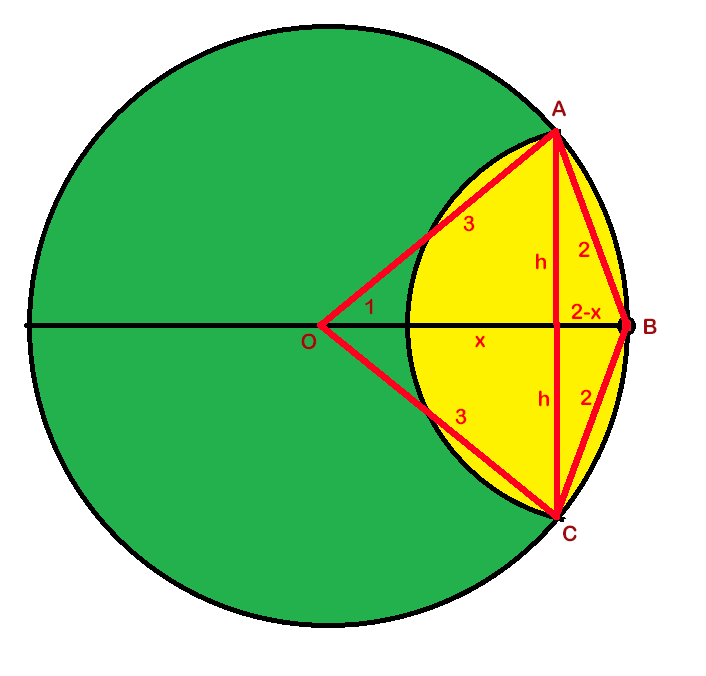
Law of Cosines on AOB: 4 = 9 + 9 - 18 cos AOB -> cos AOB = 7/9
Law of Cosines on ABO: 9 = 4 + 9 - 12 cos ABO -> cos ABO = 1/3
Pythagorean Theorem: h^2 = 9 - (x + 1)^2 = 4 - (2 - x)^2 -> x = 4/3 -> h = 4 sqrt(2) / 3
The area of the yellow sector to the left of AB = 2 angle AOB / (2 PI) * (2 PI)^2 - 1/2 * 2h * (2 - x) = 4 arccos 1/3 - 8 sqrt(2) / 9
The area of the yellow sector to the right of AB = 2 angle ABO / (2 PI) * (3 PI)^2 - 1/2 * 2h * (x + 1) = 9 arccos 7/9 - 28 sqrt(2) / 9
The total area of the yellow sector = 4 arccos 1/3 + 9 arccos 7/9 + (8 + 28) sqrt(2) / 9
The polar equation of the small circle is r = 2;
The polar equation of the large circle is r = 6 cos(x).
Solving this set of two equations, we get the intersection polar point (r, x) = (2, arccos(1/3) )
Using the online integration calculator, we get
−9(sin(2 arccos(1/3))+2 arccos(1/3)−π) + 4 arccos(1/3)
Approximation: 5.384.
You LAY 290 to win 100 or 900 to win 100.Quote: ThatDonGuy
-290 (i.e. you bet 290 to win 100) that Georgia does not win this season's CFP championship game.
-900 (i.e. you bet 900 to win 100) that Alabama does not win this season's CFP championship game.
Just like you lay odds on the donít pass line or lay a point number. Youíre staking more than your potential win amount
Quote: ThatDonGuyI realize there is a puzzle "in play," but I thought I would submit a (relatively) easy one - after all, this is Easy Math Puzzles.
I got a futures sheet from William Hill offering the following bets:
-290 (i.e. you bet 290 to win 100) that Georgia does not win this season's CFP championship game.
-900 (i.e. you bet 900 to win 100) that Alabama does not win this season's CFP championship game.
Using these two bets, construct a bet where you lose a particular amount if either Georgia or Alabama wins, and you win a particular amount if neither of them does.
In other words, you bet some amount A on Alabama not to win, and some amount G on Georgia not to win, such that the amount you win or lose in the two bets combined is the same if Alabama does win as it is if Georgia does win.
What are the odds on winning that bet, in terms of the amount that you would lose if you lost the bet?
link to original post
Quote: Wizard
I show if you bet $351 on Alabama and $290 on Georgia, you lose $251 if either of them win.
If neither win, you win $139.
So, it's like laying 251 to win 139, which is equivalent to -180.5755 odds.
I hope that answers what is being asked.
link to original post
Quote: charliepatrickSuppose you wanted to place bets that the teams did win, then the odds would be 9/1 and 29/10. If you wanted to take home $100 then you would place $10 @ 9/1 and $25.64 @ 29/10 (25.64=100/3.9). Which ever result came in you would take home $100. (If you use a book value of $390, then you'd bet $39 and $100, so place $139 to win $251). The initial outlay would be $35.64, so you net odds is 64.36/35.64 (or 251/139 or +180.576).
Sticking with the £390 book - in your case you're taking the bets; so you bet $351 to win $39 and $290 to win $100. The total outlay is $641. If either teams wins you get back one of the bets which is $390, i.e. a loss of $251. If neither team wins you get $780, i.e. a profit of $139.
Thus you are essentially betting $251 to win $139: odds of 139/251 or -180.576 in US odds.
link to original post
Both correct.

Happy Independence Day!
I couldn't find a good 4th of July math puzzle this year so here is a pop holiday quiz...
2) The original 13 American colonies became the first 13 states. What became the 14 state?
3) Francis Scott Key wrote what would become the lyrics to "The Star-Spangled Banner" while watching the bombardment of what structure?
4) Leland Stanford drove a golden spike to to join the rails of the first transcontinental railroad across the United States in what US territory (now state)?
5) During the SpanishĖAmerican War battle of San Juan Hill, Theodore Roosevelt led the charge of what famed U.S. cavalry unit?
6) In what year did the Yanks go "over there" and enter World War I?
7) I was the first American in space and, on a later mission, played golf on the moon. Who am I?
2) How many Senate seats, and how many House of Representative seats are there?
3) What were the three original U.S. Cabinet departments?
4) If both the President and the Vice-President become incapacitated, who becomes President?
5) "The powers not delegated to the United States by the Constitution, nor prohibited by it to the States, are reserved to the States respectively, or to the people." This is the text of which Constitutional Amendment?
6) What requirements does the Constitution specify to become a U.S. Supreme Court Justice?
7) What system is designed to prevent one branch of government from becoming too powerful?
1) "Give me liberty, or give me death!"
2) "I only regret that I have but one life to lose for my country."
3) "Damn the torpedoes, full speed ahead!"
4) "Americans play to win at all times."
5) "The Constitution only guarantees the American people the right to pursue happiness. You have to catch it yourself."
6) "Government of the people, by the people, for the people, shall not perish from the earth."
7) "These are the times that try men's souls."
-------
a) David Farragut
b) Thomas Paine
c) Abraham Lincoln
d) Patrick Henry
e) George S. Patton
f) Benjamin Franklin
g) Nathan Hale
1. Jamestown
2. Vermont - well, that, or Kentucky, but I'll say Vermont
3. Fort McHenry - in fact, I think the poem he wrote was titled, "The Defense of Fort McHenry"
4. Trick question - when Stanford swung at the golden spike, he missed. However, it was at Promentory Point, Utah.
5. Rough Riders?
6. 1917
7. Alan Shepard
1. Speech, the press, and religion.
2. 435 Representatives and 100 Senators. I think the number of Representatives is based on how many will fit in the chamber. There have always been two Senators per state.
3. Don't know this one...
4. The Speaker of the House of Representatives
5. Either the 9th or 10th...I'll say 10th.
6. None, just as the Constitution does not say how many justices there have to be, as long as it is at least six, IIRC.
7. Separation of Powers
1) "Give me liberty, or give me death!"
d) Patrick Henry
2) "I only regret that I have but one life to lose for my country."
g) Nathan Hale - although there is serious doubt that he ever said this, especially as his last words.
"The version I heard was," his actial last words were among the lines of, "It is the duty of every officer to obey the orders of his commander-in-chief."
3) "Damn the torpedoes, full speed ahead!"
a) David Farragut
4) "Americans play to win at all times."
e) George S. Patton
5) "The Constitution only guarantees the American people the right to pursue happiness. You have to catch it yourself."
f) Benjamin Franklin
6) "Government of the people, by the people, for the people, shall not perish from the earth."
c) Abraham Lincoln
7) "These are the times that try men's souls."
b) Thomas Paine - the opening line of "Common Sense", as I recall
1. What is the one thing in the Constitution (well, now that it's after 1808) that cannot be changed?
2. What is the one day of the week specified in the Constitution that still applies?
3. "After the first enumeration required by the first article of the Constitution, there shall be one Representative for every thirty thousand, until the number shall amount to one hundred, after which the proportion shall be so regulated by Congress, that there shall be not less than one hundred Representatives, nor less than one Representative for every forty thousand persons, until the number of Representatives shall amount to two hundred; after which the proportion shall be so regulated by Congress, that there shall not be less than two hundred Representatives, nor more than one Representative for every fifty thousand persons."
What Constitutional significance does this have?
Quote: ThatDonGuy
1. Jamestown
2. Vermont - well, that, or Kentucky, but I'll say Vermont
3. Fort McHenry - in fact, I think the poem he wrote was titled, "The Defense of Fort McHenry"
4. Trick question - when Stanford swung at the golden spike, he missed. However, it was at Promentory Point, Utah.
5. Rough Riders?
6. 1917
7. Alan Shepard
1. Speech, the press, and religion.
2. 435 Representatives and 100 Senators. I think the number of Representatives is based on how many will fit in the chamber. There have always been two Senators per state.
3. Don't know this one...
4. The Speaker of the House of Representatives
5. Either the 9th or 10th...I'll say 10th.
6. None, just as the Constitution does not say how many justices there have to be, as long as it is at least six, IIRC.
7. Separation of Powers
1) "Give me liberty, or give me death!"
d) Patrick Henry
2) "I only regret that I have but one life to lose for my country."
g) Nathan Hale - although there is serious doubt that he ever said this, especially as his last words.
"The version I heard was," his actial last words were among the lines of, "It is the duty of every officer to obey the orders of his commander-in-chief."
3) "Damn the torpedoes, full speed ahead!"
a) David Farragut
4) "Americans play to win at all times."
e) George S. Patton
5) "The Constitution only guarantees the American people the right to pursue happiness. You have to catch it yourself."
f) Benjamin Franklin
6) "Government of the people, by the people, for the people, shall not perish from the earth."
c) Abraham Lincoln
7) "These are the times that try men's souls."
b) Thomas Paine - the opening line of "Common Sense", as I recall
1. What is the one thing in the Constitution (well, now that it's after 1808) that cannot be changed?
2. What is the one day of the week specified in the Constitution that still applies?
3. "After the first enumeration required by the first article of the Constitution, there shall be one Representative for every thirty thousand, until the number shall amount to one hundred, after which the proportion shall be so regulated by Congress, that there shall be not less than one hundred Representatives, nor less than one Representative for every forty thousand persons, until the number of Representatives shall amount to two hundred; after which the proportion shall be so regulated by Congress, that there shall not be less than two hundred Representatives, nor more than one Representative for every fifty thousand persons."
What Constitutional significance does this have?
link to original post
Correct!!
Grade A
2) Yes, Vermont was 14 and Kentucky was 15.
3) Fort McHenry. Note that the Star Spangled Banner flag raised at the fort had 15 stripes to indicate 15 states (see 2 above), an idea that was later dropped to prevent flag clutter.
4) Utah. As ThatDonGuy mentions, he missed the spike, much to the amusement of the working men in attendance.
5) The Rough Riders became the most famous unit in the war. How could they not? Roosevelt himself wrote their history.
6) 1917. The "War to end all Wars" would itself end in 1918.
7) Alan Shepard. He was also the oldest man (47) and the only Mercury Seven astronaut to walk on the moon.
2) Senate=100 House=435 (+6 nonvoting members)
3) The departments of State, War (now Defense) and Treasury. Note that in those days the Attorney General would also attend Cabinet meetings but not the VP who, as the President of the Senate, was considered part of the legislative branch.
4) The Speaker of the House. This situation has never come up (except maybe the Lincoln assassination). Usually you only hear about it when there's an unpopular administration and people dream of ways to get around it.
5) The 10th Amendment. Although the 1st and 2nd Amendments generate the lion's share of arguments these days, the 10th is no slouch at conflict. It was most notably referenced during the debates over slavery leading to the Civil War. More recently it was cited to overturn Roe v Wade and send abortion law to the states.
6) None, although I hope nominees have at least graduated from Jr. High.
7) Checks and balances. This is a citizenship test question.
2) g These are Hale's purported last words at his execution for spying. There is some debate about them since the British officer reporting them was not present at the hanging, merely passing on the report from those who were. The line is also similar to one in a play that was popular at the time so somebody was quoting or misquoting somebody. At any rate, the words are Hale's now.
3) a This is how the quote is usually paraphrased. What Farragut actually said was "Damn the torpedoes. Four bells, Captain Drayton, go ahead. Jouett, full speed." Although accurate, it doesn't exactly have the same motivational speaking ring as the famous paraphrase.
4) e This is from one of two speeches that were combined and edited down to the speech at the beginning of the film "Patton" (1970).
5) f This is another quote that historians debate over its accuracy. On one hand it doesn't sound very colonial; On the other hand it has Franklin's sense of wit and humor.
6) c The last line of Lincoln's Gettysburg Address.
7) b This is the first line from the first "American Crisis" pamphlet that Paine published during the American Revolution. It was written to inspire people during the winter of 1776. Paine signed the pamphlets with the pseudonym, "Common Sense" to capitalize on his earlier success.
Quote: ThatDonGuy
1. What is the one thing in the Constitution (well, now that it's after 1808) that cannot be changed?
2. What is the one day of the week specified in the Constitution that still applies?
3. "After the first enumeration required by the first article of the Constitution, there shall be one Representative for every thirty thousand, until the number shall amount to one hundred, after which the proportion shall be so regulated by Congress, that there shall be not less than one hundred Representatives, nor less than one Representative for every forty thousand persons, until the number of Representatives shall amount to two hundred; after which the proportion shall be so regulated by Congress, that there shall not be less than two hundred Representatives, nor more than one Representative for every fifty thousand persons."
What Constitutional significance does this have?
link to original post
2) Election day (Tuesday)
3) The number of seats in the House of Representatives. (If correct, it would be an interesting math puzzle.)
Quote: Gialmere
1) Located in what would become the state of Virginia, what was the first permanent English settlement in the Americas?
2) The original 13 American colonies became the first 13 states. What became the 14 state?
3) Francis Scott Key wrote what would become the lyrics to "The Star-Spangled Banner" while watching the bombardment of what structure?
4) Leland Stanford drove a golden spike to to join the rails of the first transcontinental railroad across the United States in what US territory (now state)?
5) During the SpanishĖAmerican War battle of San Juan Hill, Theodore Roosevelt led the charge of what famed U.S. cavalry unit?
6) In what year did the Yanks go "over there" and enter World War I?
7) I was the first American in space and, on a later mission, played golf on the moon. Who am I?1) Name three freedoms granted by the 1st Amendment of the U.S. Constitution.
2) How many Senate seats, and how many House of Representative seats are there?
3) What were the three original U.S. Cabinet departments?
4) If both the President and the Vice-President become incapacitated, who becomes President?
5) "The powers not delegated to the United States by the Constitution, nor prohibited by it to the States, are reserved to the States respectively, or to the people." This is the text of which Constitutional Amendment?
6) What requirements does the Constitution specify to become a U.S. Supreme Court Justice?
7) What system is designed to prevent one branch of government from becoming too powerful?Pair the number of the quote to the letter of the American it's attributed to.
1) "Give me liberty, or give me death!"
2) "I only regret that I have but one life to lose for my country."
3) "Damn the torpedoes, full speed ahead!"
4) "Americans play to win at all times."
5) "The Constitution only guarantees the American people the right to pursue happiness. You have to catch it yourself."
6) "Government of the people, by the people, for the people, shall not perish from the earth."
7) "These are the times that try men's souls."
-------
a) David Farragut
b) Thomas Paine
c) Abraham Lincoln
d) Patrick Henry
e) George S. Patton
f) Benjamin Franklin
g) Nathan Hale
link to original post
1. Roanoake
2. West Virginia (my second guess would be Maine)
3. Fort McHenry in Baltimore
4. Utah
5. Rough Riders
6. 1914
7. Alan Sheppard
1. Roanoake
2. West Virginia (my second guess would be Maine)
3. Fort McHenry in Baltimore
4. Utah
5. Rough Riders
6. 1914
7. Alan Sheppard
1. ?
2. 100 Senators, 435 Representatives
3. War, treasury, state
4. Speaker of the House (Kevin McCarthy)
5. ?
6. ?
7. Checks and balances
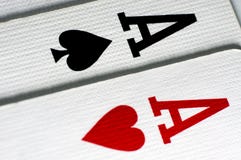
A player chooses a number K ≤ 52 and the top K cards are drawn one by one from a properly shuffled standard deck of 52 cards. The player wins if the last drawn card is an ace AND if there is exactly one more ace among the cards drawn. Any other result loses.
Which K should the player choose to maximize the chance of winning the game?
Quote: GialmereQuote: ThatDonGuy
1. What is the one thing in the Constitution (well, now that it's after 1808) that cannot be changed?
2. What is the one day of the week specified in the Constitution that still applies?
3. "After the first enumeration required by the first article of the Constitution, there shall be one Representative for every thirty thousand, until the number shall amount to one hundred, after which the proportion shall be so regulated by Congress, that there shall be not less than one hundred Representatives, nor less than one Representative for every forty thousand persons, until the number of Representatives shall amount to two hundred; after which the proportion shall be so regulated by Congress, that there shall not be less than two hundred Representatives, nor more than one Representative for every fifty thousand persons."
What Constitutional significance does this have?
link to original post1) Don't know.
2) Election day (Tuesday)
3) The number of seats in the House of Representatives. (If correct, it would be an interesting math puzzle.)
link to original post
2 and 3 are incorrect, but you're on the right track with 3.
Quote: GialmereA player chooses a number K ≤ 52 and the top K cards are drawn one by one from a properly shuffled standard deck of 52 cards. The player wins if the last drawn card is an ace AND if there is exactly one more ace among the cards drawn. Any other result loses.
Which K should the player choose to maximize the chance of winning the game?
link to original post
The player wins if there are exactly 2 Aces in the first K-1 cards, and the first card of the remaining 53-K is also an Ace.
There are C(52, K-1) sets of cards for the first K-1, of which 6 C(48, K-3) have exactly two Aces.
If there are two Aces in the last 53-K, the probability that the first is an Ace is 2 / (53-K)
The total probability = 6 C(48, K-3) / C(52, K-1) x 2 / (53 - K) = (K-1) (K-2) (52-K) / 1,082,900.
The maximum is at K = 55/3 + sqrt(2788)/3 = about 35.934, so the solution is whichever of 35 and 36 is higher
P(K = 35) = about 0.05284144, and P(K = 36) = about 0.05274725, so the solution is 35.
Consider the deck of cards and which positions the Aces are.
In total there are 52*51*50*49/4/3/2/1=270725 ways.
For each K, which represents where the 3rd Ace is, the number of ways this can happen is:
(i) The number of ways of putting two Aces in the first (K-1) positions = (K-1)(K-2)/2
(ii) The number of ways of putting one Ace in the last (5t2-K) positions = (52-K)
Thus the numbers for 34-36 are 528*18=9504 561*17=9537 595*16=9520.
Thus I get the chances of winning with K=35 as 9537/270725 or about 3.52%.
I'll let this one ride...
Quote: GialmereSorry guys. Both incorrect.
I'll let this one ride...
link to original post
I read the problem wrong - I thought it said that that there were was one Ace remaining, rather than one in the already drawn cards (and, as a result, two remaining).
The player wins if there is exactly 1 Ace in the first K-1 cards, and the first card of the remaining 53-K is also an Ace.
There are C(52, K-1) sets of cards for the first K-1, of which 4 C(48, K-2) has exactly one Ace.
If there are three Aces in the last 53-K, the probability that the first is an Ace is 3 / (53-K).
The total probability = 4 C(48, K-2) / C(52, K-1) x 3 / (53 - K) = (K^3 - 104 K^2 + 2755 K - 2652) / 541,450
This is a maximum when K = 18
Inauguration Day
Quote: ChesterDog
I get that the goat can graze this area:
9 arctan[ 4sqrt(2) / 7 ] + 4 arctan[ 2sqrt(2) ] - 4 sqrt(2), which is approximately 5.384.
link to original post
I now agree with your answer. Thank you.
Quote: GialmereMeanwhile, back at the casino...
A player chooses a number K ≤ 52 and the top K cards are drawn one by one from a properly shuffled standard deck of 52 cards. The player wins if the last drawn card is an ace AND if there is exactly one more ace among the cards drawn. Any other result loses.
Which K should the player choose to maximize the chance of winning the game?
link to original post
Taking the derivative of (k - 1)(52 - k)(52 - k - 1) gives us: 3x^2 - 208x + 2755
Setting that formula to zero and solving for x gives us the maximum value of (104 - 2551^.5) / 3 =~17.83
Thatís assuming k is a continuous variable. Since itís discrete, round to 18


